Technological Innovation in Focus A Brief Narrative
Technology Enhanced Learning (TEL) aspedagogicalas pedagogical –knowledge -innovation.
Following the description by (Kirkwood and Price, 2014), TEL is the integration of information and communication technologies to improve the learning and teaching processes by adding value to an academic performance outcome of students (OU,2020). We can recognise TEL, as a technology technological innovation in line with (Vincent-Lancrinet al., 2019) in terms of product innovation and process innovation. Hence, in line with block 1 technology definition, we can also recognise TEL as a knowledge innovation (OU, 2020). As mentioned by (Duval, Sharples and Sutherland, (2017), “TEL harnesses the power of interactivity and has the potential to enhance what is learned, how we learn and how we teach”,. As as a service innovation, as (Barras, 1986), (cited in OU, 2020) has explained, IT dissertation help is crucial in understanding these innovations. Schools are currently experience experiencing the requirements of arranging for to increasing increase utilisation of ICT within the classroom. This is congruent with ( Conole et al., 2008) regarding the overall technological ethos to in which the new generation is subjected. From this perspective,it, it is also possible to understand TEL as a social innovation in the way that addresses not just a market need but a social one (Mulgan et al., 2007), (cited in OU, 2020). Therefore, product innovation shadows the urgent requirement, which that the schools are currently experience experiencing to innovate the process for the proposed educational services which that they offer. As a regional, national and sectorial innovation in the way, thatthe schools are connected through a network of institutions (Dodgson et al., 2008), (cited in OU, 2020), which share between them common policies and standards. “Successful integration of ICT into teaching and learning requires rethinking the roles of teachers and reforming their preparation and professional development. It calls for promoting a culture of quality in all its aspects: staff support, student support, curricula design, course design, course delivery, strategic planning and development” (UNESCO, 2018). Historically, TEL have included films, radio and television (Sen and Leong, 2019). The present study focuses on what current digital computer systems can bring into education. That is, the interactivity, that which has the potential to enhance the teaching and learning process (Duval, Sharples and Sutherland, 2017).

From the point of view of interactivity, TEL tools aim at artificial intelligence in education (AIED). Historically, it is possible to state that, there are three major interactivity breakthroughs (mechanical teaching machines; machine learning; deep learning). The first steps started with the work of the psychologists Sidney Pressey, Professor at Ohio State University 1920s, and B.F. Skinner, Professor Harvard Uni. 1948-1974, known as the father of Behaviourism. Sidney Pressey saw the mechanical teaching machine as a possibility to guarantee immediate feedback to the students. His work focused on improving the multiple-choice test to consolidate students’ learning. Skinner’s machine,machine went a step further,by, by distinguishing between the subject content, pre-programmed into the machine and the student’s achievement. In this sense, Skinner machine foreshadowed TEL’s intelligent tutoring system (AIED) and machine learning (Holmes, Bialik and Fadel, 2019). However responsive, in the sense that, it would provide instant feedback by revealing the correct answer, Skinner’s machine, cannot be considered adaptive. This further means that, it would not adjust either the questions or the presentation sequence to the needs of the student (Holmes, Bialik and Fadel, 2019). During the fifties, Gordon Pask developed the first adaptive teaching machine. This key milestone, together with the advent of the first computers available, boosted the spreading of the first Computer-Aided Instruction (CAI) systems during the sixties and seventies. PLATO is considered one early influential CAI system, allowing a great number of students to access interactive teaching materials via remote controls (Holmes, Bialik and Fadel, 2019), which can be seen as an early example of the later Massive Online Open Courses (MOOCs). However, CAI systems, lacked adaptability, provided that, the sequence of topics, the content provided and the response to students’ performance were predefined, missing students individual learning needs (Holmes, Bialik and Fadel, 2019). During the sixties, CAIs were followed by the TICCT (time-shared interactive computer-controlled information television) systems. Traditional CAI systems were succeeded by SCHOLAR. The first Intelligent Tutoring System (ITS) credited to Jaime Carbonell, 1970, was adaptive, tailoring individual responses to students’ statements by making use of a semantic network. In this sense, SCHOLAR is considered the first system to implement AI techniques (Holmes, Bialik and Fadel, 2019).
TEL as we know it today has been boosted by the advent of Deep Learning (DL). DL is an AI technology, conceptualised by Geoffrey Hinton in the Eighties, thatEighties, which uses an “algorithm structured similar to the organisation of neurons in the brain” (freecodecamp, 2020). During the second decade of the 21st century, the exponential growth of computer power and the access to large amounts of data created the perfect conditions to the field of learning analytics to sprout up (‘ai100report10032016fnl_singles.pdf’, 2016), boosting the development of the technologies with the potential to enhance teaching and learning. DL capacity to model complex data promises a breakthrough in terms of data-driven forecasting, paving the way for schools to better understand the process of human learning(learning (eLearning Industry, 2020). However, AIED doesn’t come without flaws and space for improvement. When handling personal data, the schools have to embed their practice with several privacy and security mechanisms, such as Europe’s new General Data Protection Regulations (GDPR) (Inc., 2020). Some AI learning systems, such as the Assessment and Learning in Knowledge Space (ALEKS), were found to have discrepancies, when applied in different social backgrounds, grading minorities differently,perpetuating, perpetuating social bias failing to deliver the same level of personalisation expected from a human teacher (Lexalytics, 2020). There are also, different understandings about what AIED approach should be adopted. In one side, AI assisted, where the teachers keep play an active role with creative tasks. On the other side, an AI lead technology, where the teachers are passive actors, they are just intervening when there is a problem (Lexalytics, 2020).
For the systems map you should state your perspective and identify all systems and subsystems relevant to your case study and the context in which it has been or is being developed.
Systems map
TEL is a product and process innovation resulting in knowledge innovation (OU, 2020). Knowledge is here observed from a pedagogical innovation perspective, being central to the approach adopted.Technologyadopted. Technology innovation, is here taken as a social mode of enquiryandenquiry and action (OU, 2020), that encompasses all the other systems (OU, 2020). In terms of the technology available, national system sets what is available and expected in regional and sectorial terms (OU, 2020). The technology market, assumes a closed position, illustrating the push and pull effect caused by the development of TEL tools (OU, 2020). As a social innovation, it pushes the implementation of TEL tools to minimize the mismatch between technology that students have access to outside school (informal learning) and inside school (formal learning) (OU, 2020).
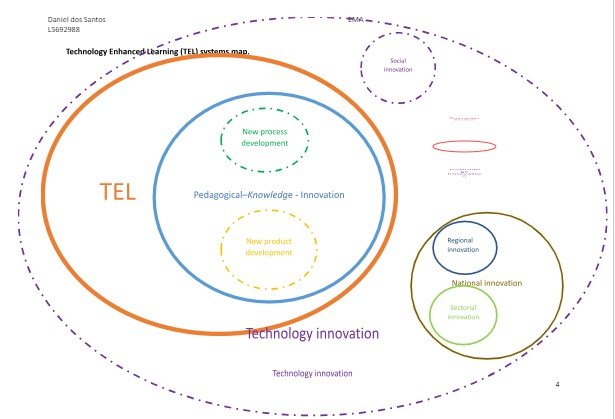
For the stakeholder analysis you should state the perspective from which you conduct the analysis. Also, discuss how you defined your chosen stakeholders and any benefits and costs and problems and issues that might (or did) arise from their involvement or potential involvement. (Note: If you have multiple stakeholders you should restrict your discussion to a suitable number and range of those that you define as most significant to fit within the word limit you have available).
Stakeholder analysis
For the present case study, the stakeholders were chosen by their level of interestandinterest and power in the development and implementation of TEL tools(tools (Barrow, 2000), (cited in OU, 2020). Therefore, from the core of the teaching and learning practice, the teachers, assistants and students are the main actors setting the study’s perspective. Though they do not hold the most influential position, they establish how we learn and what teaching approach couldenhancecould enhance that process. In a more general view, the school as an educational public institution,institution incirclesencircles educational policies, TEL tools and strategies available. As a public organisation,addresses, addresses all the other aspects such as admin tasks, cross-curriculum/faculties strategies and the link with the local community. Policy makers hold the most influential position by setting the national educational standards, thatstandards, which all the other stakeholders have to observe. The technology market plays a significant role by providing the technology available with the potential to enhance the teaching and learning process. The local community being here positioned as the less influential stakeholder, it is also included due to the consistent presence in all the educational process (OU, 2020).
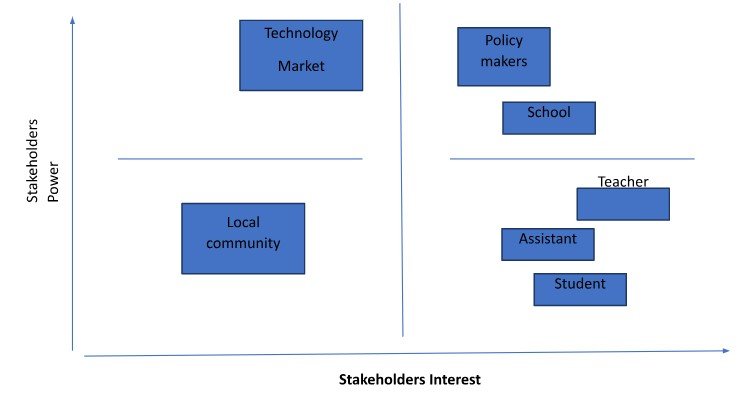
In the second part of your EMA, you should provide a critique of your case study building on the work you did for Part 1 of TMA 03. This might be an examination of the overall approach taken to the innovation or may focus on a specific phase. For example, you might want to assess your case study in terms of the openness of the innovation process or application of eco-innovation ideas. Alternatively, you might want to look at a specific set of decisions and the strategy behind these. This might entail looking at a specific issue affecting the innovation process, such as those highlighted in Activity 8 or Activity 9 in Block 2. Or, perhaps utilise further material on value or evaluation from Block 5, thus adding to or extending the work you did for Part 2 of TMA03. Whatever you chose to utilise your critique should clearly identify the benefits and limitations of the approach taken and set out realistic recommendations that are grounded in an effective diagnosis of the features, factors, and situational conditions relevant to your case study.
It is not technology as an artefact that best translates the present study’s direction, but how the application of TEL tools builds and affects the pedagogic paradigm, translatedheretranslated here as knowledge (OU, 2020). How value is added (OU, 2020), by the introduction of new content delivery and accessing information methods, which allow new pedagogic strategies to engage and assess the students? This approach implies the need to understand the concept of TEL as a branch of Learning Science (Duval, Sharples and Sutherland, 2017). How people represent their knowledge, and in what way technology is able to enhance that process. Nowadays, we are not just absorbers of information but constructors of knowledge(Duval, Sharples and Sutherland, 2017).
Accordingly with (McKnight et al., 2016) TEL innovation in classrooms happens when technology improves teaching and learning. However, comparative research is not consensual on the advantage for digital learning. Some studies point out the value that digital classrooms bring into the teaching/learning practice (Clariana, 2009; Holcomb, 2009; Silvernail & Gritter, 2007; Suhr, Hernandez, Grimes, & Warschauer, 2010), cited by (McKnight et al., 2016). Others, that there is no relevant difference or the reverse happens(Cuban, 2006; Gavriel, 2002; Holcomb, 2009; Penuel, 2006; Silvernail & Lane, 2004; Warschauer& Grimes, 2005), cited by (McKnight et al., 2016). One first reason for such disparity,disparity is the unclear understanding about the meaning of “enhancement”. It is not consensual what is intended by “enhancement”. Following (Kirkwood and Price, 2014), the meaning of “enhancement” unfolds three questions: what will be enhanced, how enhancement will be achieved and how to assess it. The Higher Education Funding Council for England (HEFCE), points out three potential benefits that TEL might provide: Efficiency – processes carried out in a more cost-effective, time-effective, sustainable or scalable manner. Enhancement – improving existing processes and the outcomes. Transformation – radical, positive change in existing processes or introducing new processes (Kirkwood and Price, 2014). The school as a public institution and one of the stakeholders,stakeholders will tend to focus more on the aspect of Efficiency. While the teacher, assistants and students, as central stakeholders, are more concerned with the aspect transformational (Kirkwood and Price, 2014). From a transformational perspective, there is a lack of research focusing on the way that the teachers apply technology to enhance teaching/learning. However, what is more common in practice, is that technology as an artefact (OU, 2020), is implemented in a way that tends to replicate traditional teaching strategies even if changing the method (Blin & Munro 2008; Eynon 2008; Roberts 2003), cited by (Kirkwood and Price, 2014).As highlighted by Clark and Mayer (2011), when pedagogical strategies remain the same despite the medium employed, so does the learning outcome, this is, TEL innovation value (OU, 2020). A systems approach emphasises the need to understand the problem as a whole as a premise to develop, implement and assess the innovative impact that TEL tools have or may have within the classroom (OU, 2020). Hence, the definition of the relation between the different stakeholders (OU, 2020): the teacher, the student, the school as an educational institution and public organisation.Theorganisation. The policy makers, the local community and the technology market push and pull effect (OU, 2020). Are paramount to understand how TEL tools are changing the pedagogic paradigm in terms of knowledge (OU, 2020), by adding value to the teaching and learning process (OU, 2020). This way, we can understand that TEL as a pedagogic innovation,beinginnovation, being the key that entails changes in product, process, marketing and organisation (OU, 2020), it is always necessarily driven by an understanding of how people learn (Ferguson, Rebecca, 2019). This means that, when “new” technologies such as whiteboards, computers and augmented reality, as artefacts (OU, 2020) are used to engage and enthuseencourage the learners without any pedagogical rationale behind it. Will no longer work when not perceived as “new” anymore (Ferguson, Rebecca, 2019). The bellow table, states 16 learning methods that have been traditionally employed without technology but that technology allows a widening of possible applications.
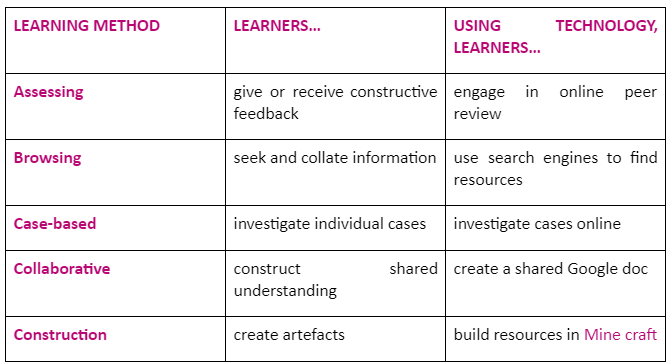
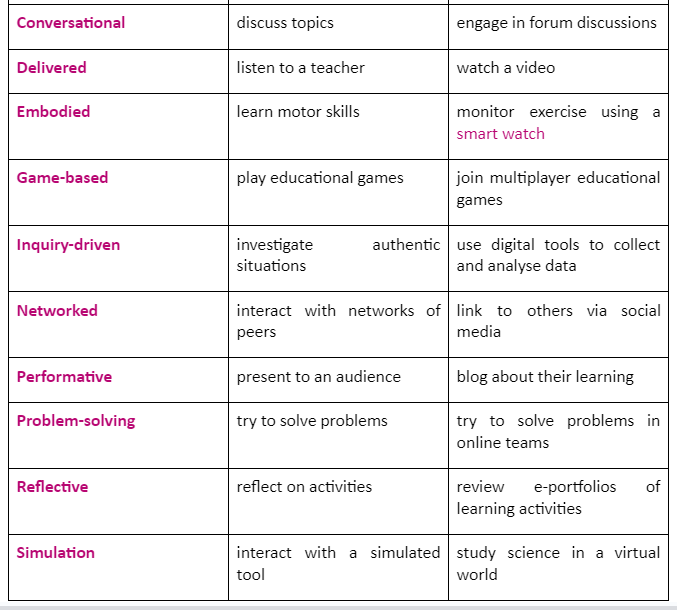
2019). Technology can provide six general ways to enhance the teaching and learning process: Connectivity – The internet boasts a wide range of tools, that which allow support networked; Extension – Technology provides creative exploration tools, offering opportunities to bridge formal learning - inside the classroom and informal learning - outside the classroom. Inquiry – The implementation of TEL allows new means and structures for collecting, measuring and organising data from new reference sources; Personalisation – The use of technology generates data (input) that can potentially be used in an intelligent way (AI) creating personalised learning paths (process), enhancing the learning output (OU, 2020); Publication – Technology allows the access and share of information beyond local audiences, connecting the learners with a worldwide audience; Scale – Through technology, education can now be delivered at scale. Courses such as massive open online courses (MOOCs) enhance the interaction between learners around the globe, allowing the share of ideas and different perspectives. In this sense, following (Scanlon et al., 2013), cited by (Ferguson, Rebecca, 2019) for the successful implementation of TEL, technology as an artefact needs to be regarded as an extension of pedagogy as knowledge (OU, 2020).
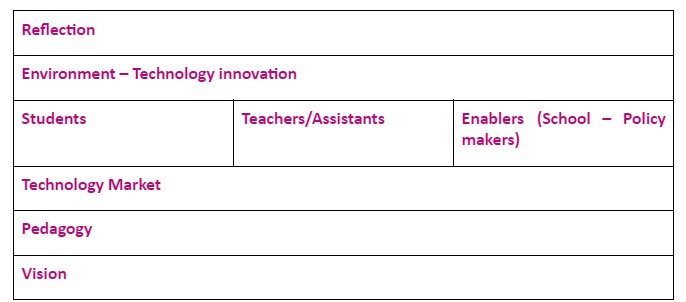
Figure 1, illustrates that, the effective implementation of TEL is driven by a vision focused not on the technology per se but on the potential to enhance the teaching and learning process by the use of technology. Once a vision is established on what learning outcome in intended to be achieved, there is the need to find the pedagogical strategies and the technology available to accomplish such vision. (Ferguson, Rebecca, (2019) points pointed out that, at this stage, it is possible to check if the technology adopted is innovative, this is, if it adds value by enhancing the teaching and learning practice (OU, 2020), or if it is possible to achieve the same outcome with traditional tools and approaches such as pen, paper and conversation. If the The vision has the potential to become a pedagogical innovation by the introduction of TEL tools.Thetools. The next block shows us that students, teachers and assistants, the school and policy makers, as mainstakeholdersmain stakeholders (OU, 2020) are of central importance to the successful implementation of TEL tools with pedagogical value. There is the need to consider the skills and training required to use those tools. How will students and teachers react to the introduction of new tools and teaching/learning methods? How can the school as a public institution driven by national and sectorial educational policies accommodate such changes in order to support pedagogical innovation? Will these changes enhance the link between school and local community such as parents, careers and local industry? Or will they find opposition by disrupting the link already established (OU, 2020)? The interaction between the different stakeholders takeinteraction between the different stakeholders takes us to the next block that is environment.Environmentenvironment. Environment encompasses the potential for technology innovation within a certain social context. This is, apart from technology as an artefact, thatartefact, which is readily available, released from the technology market. There is the need to consider sectorial/regional/national - contextual environment circumstances, that may limit or boost the successful introduction of innovative TEL tools. The last block suggested by (Scanlon et al., 2013), cited by (Ferguson, Rebecca, 2019) invite us for a reflection on the process followed. Has the outcome achieved kept loyal to the vision that drove the implementation of technology to enhance teaching and learning? If not, is there the need to update that vision? If yes, is there room to improve the outcome by refining any of the building blocks such has environment or pedagogy?

From the centre of the stage where the implementation of TEL tools take place. The relation between teachers and student, as the main stakeholders of the present case study (OU, 2020), is of dominant significance. Teachers are responsible for providing an optimal learning environment by engaging students with a personalised educational plan enhanced by technology (Darling-Hammond, Austin, Orcutt & Rosso, 2001), cited by (McKnight et al., 2016). Research-based principles of learning, highlights that providing students with the choice and responsibility for their learning process, by making available multiple pathways, allows for individualized learning to take place in a learner-centred approach to teaching (Hannum & McCombs, 2008; McCombs & Vakili, 2005; Reigeluth & Karnopp, 2013), cited by (McKnight et al., 2016). Therefore, the implementation of TEL tools with the innovative potential to enhance teaching and learning process needs to be sustained by a pedagogical vision, based on a learner-centred approach. This way, regarding the implementation of TEL tools, the pedagogical learner-centred approach needs to focus on how to adopt technology to expand the learning outcome by focusing on how people learn and how technology can enhance those processes (e.g., Mayer, 2009; McCombs, 2008; McCombs &Vakili, 2005; Reigeluth & Karnopp, 2013), cited by (McKnight et al., 2016). As stated by ( Scanlon, Eileenet al, (2013), the successful implementation and evaluation of TEL tools require more than just theoretical models. It demands the articulation of the several stakeholders involved in the development and implementation process, moved by an educational vision, through a creative management of the environment and available resources. This means, that simply measuring the effects of implementing technology may miss the target that is to evaluate how technology can be used to enhance learning. Therefore, based on (Weiss, 1998) cited by (OU, 2020), process evaluation would be a possible approach to understand the relation between technology as an artefactandartefact and process implemented on top of a pedagogic vision with the potential to add value (OU, 2020), by facilitating pedagogical knowledge– innovation (OU, 2020).
Looking for further insights on Sustainable Supply Chain Management and Risk? Click here.
References:
ai100report10032016fnl_singles.pdf’ (no date). Available at: https://ai100.stanford.edu/sites/g/files/sbiybj9861/f/ai100report10032016fnl_singles.pdf (Accessed: 19 June 2020)
Duval, E., Sharples, M. and Sutherland, R. (eds) (2017) Technology Enhanced Learning. Cham: Springer International Publishing. doi: 10.1007/978-3-319-02600-8.
eLearning Industry (2019) 5 ways AI is changing the Education Industry [Online]. Available at https://elearningindustry.com/ai-is-changing-the-education-industry-5-ways (Accessed 20 June 2020)
freecodecamp (2020) deep-learning-neural-networks-explained-in-plain-english[Online]. Available at https://www.freecodecamp.org/news/deep-learning-neural-networks-explained-in-plain-english/ (Accessed 02 July 2020
Kirkwood, A. and Price, L. (2014) ‘Technology-enhanced learning and teaching in higher education: what is “enhanced” and how do we know? A critical literature review’, Learning, Media and Technology. Routledge, 39(1), pp. 6–36. doi: 10.1080/17439884.2013.770404.
McKnight, K., O’Malley, K., Ruzic, R., Horsley, M. K., Franey, J. J. and Bassett, K. (2016) ‘Teaching in a Digital Age: How Educators Use Technology to Improve Student Learning’, Journal of Research on Technology in Education, 48(3), pp. 194–211. doi: 10.1080/15391523.2016.1175856.
‘Pedagogical Innovations_TEL.pdf’ (no date). Available at: http://oro.open.ac.uk/62492/1/Pedagogical%20Innovations_TEL.pdf (Accessed: 30 August 2020).
Sen, A. and Leong, C. K. C. (2019) ‘Technology-Enhanced Learning’, in Tatnall, A. (ed.) Encyclopedia of Education and Information Technologies. Cham: Springer International Publishing, pp. 1–8. doi: 10.1007/978-3-319-60013-0_72-1.
Scanlon, Eileen; Sharples, Mike; Fenton-O’Creevy, Mark; Fleck, James; Cooban, Caroline; Ferguson, Rebecca; Cross, Simon and Waterhouse, Peter (2013). Beyond prototypes: Enabling innovation in technology-enhanced learning. Open University, Milton Keynes.
‘Snapshot’ (no date). Available at: https://www.researchgate.net/publication/42795967_'Disruptive_technologies'_'pedagogic
al_innovation'_What's_new_Findings_from_an_in-depth_study_of_students'_use_and_perception_of_technology (Accessed: 1 September 2020).
UNESCO ICT Competency Framework for Teachers: version 3. (2018).
- 24/7 Customer Support
- 100% Customer Satisfaction
- No Privacy Violation
- Quick Services
- Subject Experts



